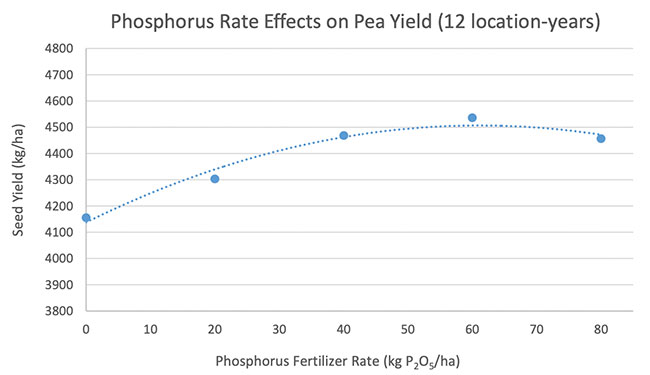
Features
Fertilizer
Field pea fertility management
Response to phosphorus fertilizer but not to sulfur or nitrogen.
March 27, 2024 By Bruce Barker
 Field pea seed yield response to phosphorus fertilizer rate in Saskatchewan.
Source: Holzapfel. 2020.
Field pea seed yield response to phosphorus fertilizer rate in Saskatchewan.
Source: Holzapfel. 2020. The ongoing high price of fertilizer means growers must scrutinize their returns from every fertilizer dollar even more carefully than before. A Saskatchewan Pulse Growers-funded study looked at the impact of different rates of nitrogen (N), phosphorus (P) and sulfur (S) in different combinations and application timings.
“The treatments were intended to allow us to measure the responses to varying rates of side-banded P and S fertilizer along with a few distinct N fertilization strategies,” says Chris Holzapfel, research manager with the Indian Head Agricultural Research Foundation at Indian Head, Sask.
Holzapfel was the lead researcher on the two-year research project conducted in 2019 and 2020 at Agri-Arm sites at Swift Current (dry Brown), Outlook (Brown), Scott (Dark Brown), Indian Head (thin Black), Yorkton (Black) and Melfort (moist Black). Soil test P levels were low at less than 12 ppm Olsen-P at 11 of 12 site-years.
Thirteen fertilizer treatments were compared to assess their impact on pea yield and protein. The treatments were different combinations of P and S rates, and several N fertilizer rates. The P source was monoammonium phosphate (11-52-0), and the sulfur source was ammonium sulfate (21-0-0-24). The N source was either urea (46-0-0) or polymer-coated urea (ESN; 44-0-0). All fertilizer was sidebanded except one treatment where N was also surface broadcast during the late vegetative stage.
Yield response to P
Averaged across all site-years, the lowest yielding treatment was the control with no fertilizer at a yield of 59.8 bushels per acre (4,016 kg/ha), followed by treatment #2 with 17-0-0-10 (0P) at 62 bu./ac. (4,155 kg/ha). The numerically highest yield was treatment #5 with 53 lb. P2O5/ac. and 9 lb. S/ac. with no extra N at 67.6 bu./ac. (4,536 kg/ha).
However, yields from most of the treatments with modest rates of P were statistically similar. On average, Holzapfel says yields were increased by nine per cent with P fertilization, and the optimum rate was 36 lb. P2O5/ac. (40 kg P2O5/ha). He says that is approximately what is required to match removal in a 50 bu./ac. (3,360 kg/ha) pea crop.
Holzapfel says while yield increases were occasionally linear at some sites, with small gains right up to the highest rate, it is unlikely that rates exceeding approximately 36 lb. P2O5/ac. would be economically justified under most conditions.
“An exception could be when the objective of the producer is for long-term building of residual P and yields of 50 bu./ac. or more are regularly achieved,” says Holzapfel.
The treatments with extra N had numerically lower yield than treatments with normal rates of N, but they were statistically similar.
“Our results did not show any benefits to N fertilization, and unless residual levels are extremely low or a nodulation failure is suspected, Saskatchewan field pea producers are advised to avoid applying any more N fertilizer than what is provided by the P and or S fertilizer products being utilized,” says Holzapfel.
There was no yield increase associated with S fertilization.
“Sulfur responses have been elusive in past research, and this was also true in the current project,” says Holzapfel. “It is unlikely that S deficiency has been much of a yield-limiting factor for the majority of field pea producers in Saskatchewan.”
For protein content, there were few significant differences between treatments. There was a significant linear increase in protein as P rate increased, but the increase was small, only increasing 0.4 per cent from zero P to 71 lb. P2O5/ac. (79 kg/ha).
“This effect might be attributable to generally healthier plants and root systems as the protein increase from phosphorus also came with a yield increase which was considerably larger in magnitude,” says Holzapfel.
Sulfur and N fertilization did not impact seed protein.
An economic analysis was conducted for each P rate, comparing two MAP prices of $550 and $750 per metric tonne, and a pea price of $6.25/bu. Averaged across all locations, the most economical P rate was 36 lb. P2O5/ac., and was the same for both MAP prices.